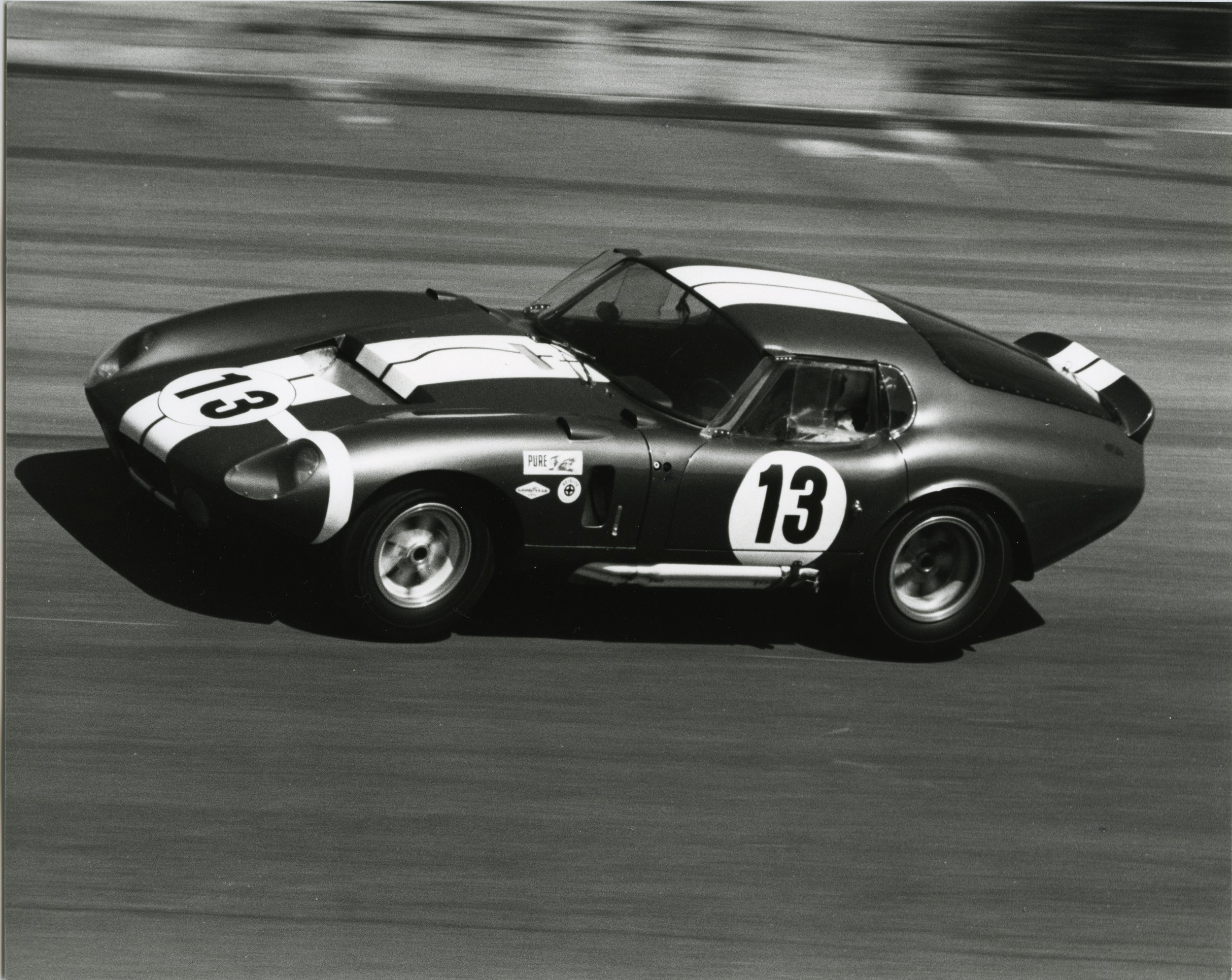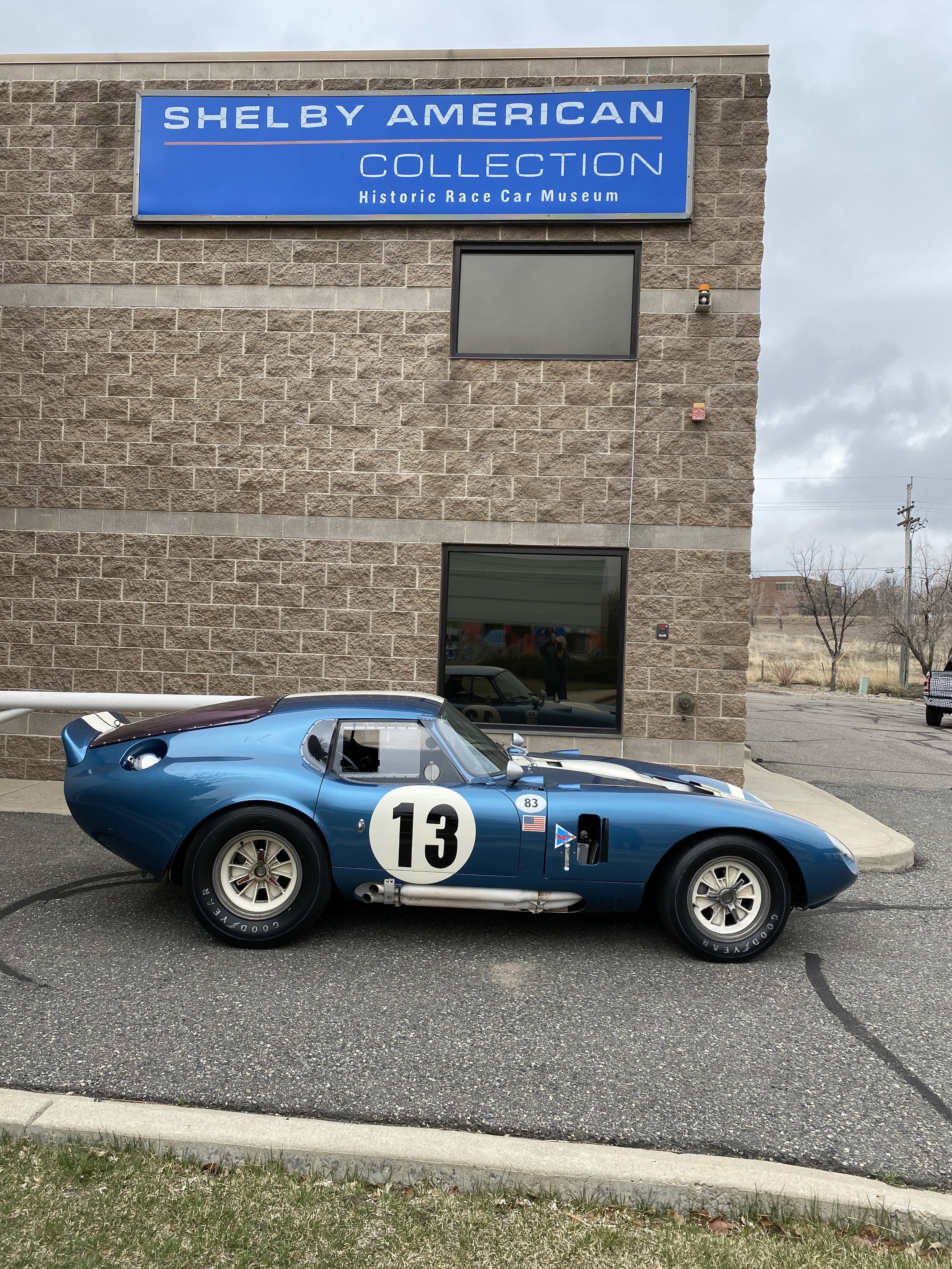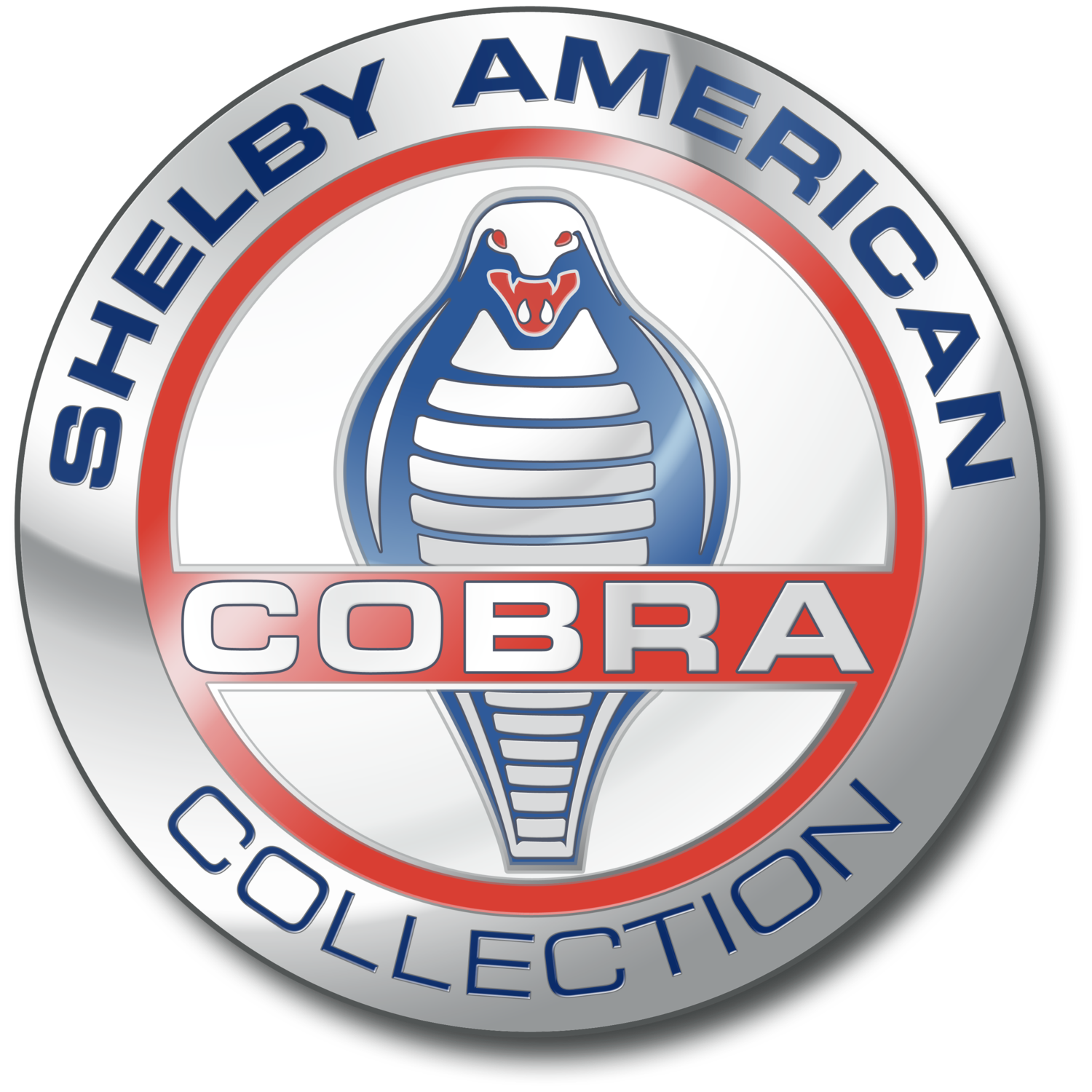1964 Daytona Coupe CSX2299
One of six Daytona Coupes






Details & History
Since the Roadster’s aerodynamic drag limited its top speed, Shelby knew that he needed a slicker car—a coupe—to win on European tracks. The FIA allowed special bodies on any chassis of which at least 100 examples would be sold. Cobra roadster sales had already exceeded 250, so here lay Shelby’s opportunity.
The tale of how Pete Brock risked his career at Shelby American to design the Coupe is oft-told. To match the speed of the Ferraris on tracks with long straights, he shaped the coupe to minimize aerodynamic drag. Lacking a wind tunnel for testing—and despite skeptical “experts” inside and outside Shelby American—Pete did what he believed would work. Then, miraculously, and without final drawings, Phil Remington and his crew of skilled fabricators took the first Coupe, CSX2287, from drafting table to track in just three months.
Right out of the box, in January 1964, Ken Miles found the Coupe three and a half seconds per lap faster around Riverside than the roadster. With the right gears, the 390- hp Coupe could exceed 185 mph, at least 30 mph better than the best roadsters; for a 24-hour race, this advantage would be enormous. The stiffer Coupe also handled better than the roadster. Most importantly, its lap times at Le Mans fell into the 3:56 to 3:59 range, down from [Info T/K] for the Roadsters (the new GT40 managed 3:45). Lower drag also reduced fuel consumption by 20 to 30 percent, allowing longer runs between pit stops. Even though the Coupes were cramped, hot, and noisy, they were less fatiguing to drive than the open roadster.
Arriving from A.C. Cars in consecutively numbered pairs, the six Coupe chassis required plenty of work before being bodied. To increase rigidity, a triangulated subframe was added over the transmission and another ahead of the rear end. To facilitate rear-end gearing changes, a section of the lower rear cross-member was removable. The 289ci V8 was lowered about an inch, and a new exhaust system had to be fabricated. New rollbar and body mounting points were installed, and the radiator was tilted forward to reduce its height and allow hot air to exit upward, through the engine cover. Special ducting, wiring, and plumbing (coolant, fuel, oil, brake fluid) had to be fabricated, and the transverse springs were modified to reduce wheel camber. The body support tubing was completely different from that of the roadsters, and for better engine access, the entire front section pivoted forward. Wheels were 15 x 6 in up front and 15 x 8 at the rear, wearing tall (80- profile) 6.70 and 8.20 Goodyear Sports Car Special tires, respectively. Despite its heavier frame, the Coupe’s weight came within about 130 lbs of the roadster’s.
The second of the six coupes to be completed, CSX2299 arrived in Los Angeles in January 1964 as a bare chassis, lacking body support tubing. Although the first Coupe, CSX2287, had been bodied at California Metal Shapers in Los Angeles, the other chassis were flown to Carrozzeria Gransport in Modena, Italy. Shelby chose that venue despite
the air-freight cost because it freed his employees for other work, put the finished cars conveniently closer to the European events, and—as a bonus—cost less. The irony of Carrozzeria Gransport being in Ferrari’s back yard must have been appealing, too.
Coupe CSX2287 was the first to compete, at Daytona in February 1964. Alas, it suffered a fire during a pit stop to remedy an overheating differential; spilled gasoline ignited beneath the car, seriously burning crew chief John ohlsen. He and the fabricators who had bodied CSX2287 had accompanied it to Daytona, so less experienced employees had to build the body framework for the recently arrived CSX2299. Inadvertently, the new crew installed its under-windshield cowl tube three-quarters of an inch higher than intended, a flaw that remained undiscovered until the Carrozzeria Gransport artisans began work—and which sets this Coupe apart from the other five.
Compounding Shelby American’s error, the windshield frame was then mounted too high. All this raised the windshield (which FIA rules forbade shortening) such that the front roof of CSX2299 was 11⁄2-in. higher than intended. Lacking the original design’s smooth “forehead” curvature, this Coupe also has unique side windows, higher at their top front corners. When Phil Remington and John ohlsen discovered the error, there was no time before Le Mans to correct it. The only body revision was a rear spoiler, recently developed on CSX2287 at Spa.
In early June 1964, the almost finished CSX2299 was loaded onto the ex-Reventlow team’s Fiat transporter with CSX2287, and driver Ermanno Cuoghi (later famous as a mechanic for John Wyer and then Ferrari) made the three-day haul from Modena to the team’s temporary shop in Paris. When the car arrived at Le Mans, it had never been driven.
Nevertheless, it made a great debut. As car 5, in Viking Blue with a pair of white stripes, CSX2299 was Dan Gurney’s choice, because the unique high roof could accommodate him. For the same reason, Bob Bondurant became his co-driver. During practice, Gurney lapped the circuit at 3:56.1, a new GT record. on the Mulsanne Straight, speeds exceeded 185 mph, though 2299 was, due to the drag caused by its different roof, fully 11 mph slower there than 2287. The two Coupes soon led the GT class over the A.C. Coupe and the Ferrari GTos, but CSX2287’s battery died, and a rules infraction during its restart disqualified the car. Now it was up to Gurney, Bondurant, and 2299. Running as high as third overall, they led the Ferrari GTs by nine laps. Then, after 16 hours, the need to bypass a leaking oil cooler raised oil temperatures to over 300 degrees F, forcing a slower pace. A failing distributor hindered Bondurant during the final hour, and as he nursed the Coupe to the flag, the Ferraris were gaining. But he made it.
In its first race, a 24-hour thrash, CSX2299 had won its class and finished fourth overall, beaten only by three Ferrari prototypes. If not for the oil cooler snag, it might have won overall. In fact, according to Bondurant, “The way the French treated us, you’d have thought we’d won the whole race.” The fledgling GT40s, also making their Le Mans race debut---they had previously appeared at the April test weekend--- proved unable to best the Coupe and failed to finish.
From Le Mans, the car went to another high-speed circuit, Reims, but after setting
the fastest GT time, Gurney, Bondurant, and car 15 failed to finish. First a broken fan belt caused engine overheating, then a new aluminum transmission tailshaft housing failed; the piece had replaced the steel original.
A month later, though, the same trio came third overall and first in class in the three-hour Tourist Trophy at Goodwood, with Gurney setting a lap record. on the same day, Bondurant won the Sierre-Montana hillclimb (driving another Cobra in the Collection, CSX2345), so Ferrari took a double points hit. The GT class at the next race, Monza, was suddenly canceled; to protect his meager points advantage, Ferrari had leaned on the organizers!
For the Tour de France, a 9-day, 17-event rally-cum-race that jumped non-stop from track to track over public roads, CSX2299 and CSX2287 gained passenger seats, air horns, yellow headlights, and other rally gear. Driven by Maurice Trintignant and Bernard de Saint-Auban but maintained by an inexperienced crew, the car faced Ferrari’s superior logistics and experience. Under Trintignant, CSX2299 (as car 188) was second at Reims, won at Rouen, and came third at Le Mans (after a flat tire), but it was finally laid low by a seized right front wheel bearing. Ferrari won the Tour and the 1964 GT championship, and CSX2299’s first race season was over.
Back at Shelby American, the car was overhauled, with new aluminum-caliper brakes and improved driver and differential cooling. A slot in the rear spoiler pulled air from the cockpit, and a temperature-resistant coating slowed heat transfer through the aluminum firewall. Air jacks would speed pit stops, and a pressurized water system aided coolant replenishment. The vulnerable oil coolers were moved behind the coolant radiators. Recognizing its Le Mans win, 2299 was re-named “Gurney’s car.”
Repainted in the new team color, Guardsman Blue, accented by two wider stripes, CSX began 1965 with three other Coupes at the 200-km Daytona Continental. Despite bearing the unlucky number 13, it carried Jo Schlesser and East Coast Cobra racer Hal Keck— making his only appearance in a Coupe—to first in GT and an impressive second overall behind Ken Miles and Lloyd Ruby in GT40 P/103 (another Collection car). A month later, at a soaking wet Sebring, Schlesser teamed with Bondurant in the Coupe—with holes punched in its floorpan to drain the cockpit—to come fourth overall, again first in GT, ahead of three other Coupes and the Corvette Grand Sports.
After its Florida successes, CSX2299 left for Europe with a fresh engine. Having narrowly lost the 1964 manufacturer’s championship to Ferrari, Shelby went all-out for 1965, shipping five Coupes over. Since GT40 development was demanding so much effort by Shelby American, they and the roadsters would be entered and managed by Alan Mann Racing.
At the Tourist Trophy at oulton Park, CSX2299 was piloted by Jack Sears, who had experience in Cobras and the Willment Coupe. At the start of the first heat, the starter failed, and Sears was penalized two laps for a push-start. Then the brakes failed, too! Finishing 15th, he recovered with an excellent 3rd in the second heat, ranking him 7th on aggregate, 4th among the GTs.
CSX2299 was given a rest for Spa and the Nürburgring but did return to Le Mans, where Sears joined American dentist and racer Dick Thompson. After a broken oil pickup led to failing pressure and a collision damaged its nose and radiator, the pair drove CSX2299 so easily that it escaped the head gasket failure that shut down the other 289 engines. Finally ranked eighth overall and third in class, CSX2299 outlasted four other Coupes, a Cobra, and six GT40s to become Ford’s sole finisher.
The car wasn’t needed for Reims, where Bondurant and Schlesser won the championship in another Daytona Coupe. The final effort for CSX2299—and Jack Sears’ last drive in it—came that August in Sicily. The 500-km Coppa di Enna took place on a bumpy, abrasive track around Lake Pergusa; lacking elevation changes, the course consisted almost entirely of fast, right-hand turns. Sears drove alone, and steadily, to fourth overall and second in GT, Despite tire wear problems, a minor accident resulting in a bent nose, oil pickup problems, flying stones from the track surface, and the partisan efforts of the Sicilian organizers—they made Bondurant refuel the other Coupe from an inconvenient pump rather than a handy dump can—the team earned sufficient points to cement the championship.
At last Ferrari was vanquished! For the first and only time, an American manufacturer had won the world championship. Yet soon after their achievement, the cars were nearly forgotten. After Enna, CSX2299 and CSX2601 were trucked back to England and stored, but given other issues facing Shelby—racing the GT40 plus developing the 427 Cobra
and the Mustang GT350—they were ignored. Alan Mann, who had imported the Coupes to England under a temporary permit, reportedly had to threaten to crush them or dump them into the sea before Shelby authorized shipment back to Los Angeles.
The Coupe’s racing career, longer than that of any other, had ended. After CSX2299 returned to Shelby American, it had a brief interlude as a show car on the Cobra Caravan, a U.S. dealer promotional tour. After serving similarly for Goodyear, it became “just another old race car” and was pushed into a storage facility with the other five Coupes. over the next few years, the others were slowly sold off, and in December 1969, still in worn but near-original condition, CSX2299 was bought for $5,100 by Michael Shoen (author of The Cobra-Ferrari Wars) and returned to running condition. When Shoen moved from Phoenix to Vancouver in 1971, he drove the car there, giving the beast its head in Nevada.
During 1964 and 1965, CSX2299 had run in 10 of the 25 races that the Daytona Coupes participated in, more than any other example. It scored four GT class wins, plus three second places and two DNFs, setting lap records at five of its races. In its second life it was restored during the early 1980s and has run in vintage events at Le Mans, the Nürburgring, Watkins Glen, Laguna Seca, and Goodwood.
On loan from the Miller Family Automobile Foundation.
Text excerpted from “Shelby Cars in Detail, Cars of the Shelby American Collection” by Frank Barrett with photography by Boyd Jaynes.
Images by Dave Friedman and Shelby American Collection.
Race History
1964 Race Season
DATE: 2/16/1964
TRACK: Daytona
PLACE: DNA
DRIVER: Dave MacDonald / Lew Spencer
DATE: 6/22/64
TRACK: Le Mans 24 Hours
PLACE: 4th
DRIVER: Dan Gurney / Bob Bondurant
DATE: 7/5/64
TRACK: Reims 12 Hours
PLACE: DNF
DRIVER: Dan Gurney / Bob Bondurant
DATE: 8/29/64
TRACK: Goodwood Tourist Trophy
PLACE: 3rd Place
DRIVER: Dan Gurney
DATE: 9/20/64
TRACK: Tour de France
PLACE: DNF
DRIVER: Maurice Trintignant / Bernard de Saint-Auban
1965 Race Season
DATE: 2/28/65
TRACK: Daytona
PLACE: 2nd
DRIVER: Jo Schlesser / Hal Keck / Bob Johnson
DATE: 3/27/65
TRACK: Sebring
PLACE: 4th
DRIVER: Bob Bondurant / Jo Schlesser
DATE: 5/1/65
TRACK: Goodwood Tourist Trophy
PLACE: 7th
DRIVER: Jack Sears
DATE: 6/20/65
TRACK: 24 Hours of Le Mans
PLACE: 8th
DRIVER: Jack Sears / Richard Thompson
DATE: 8/15/65
TRACK: Coppa Città di Enna
PLACE: 4th
DRIVER: Jack Sears
DATE: 8/30/65
TRACK: Redex Trophy Brands Hatch
PLACE: 1st
DRIVER: Jack Sears
